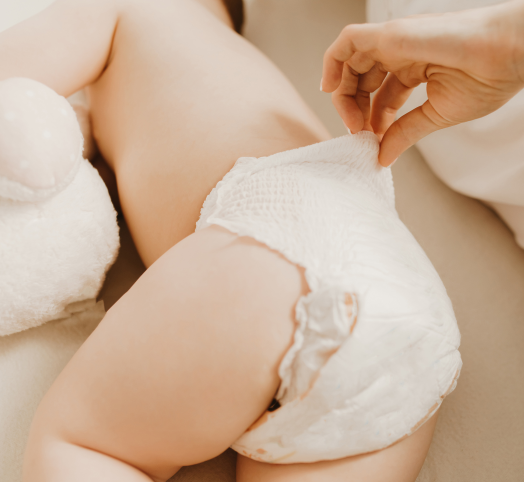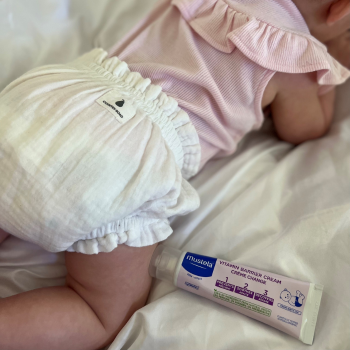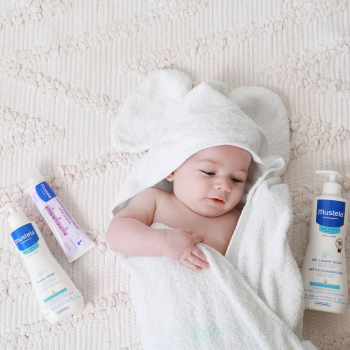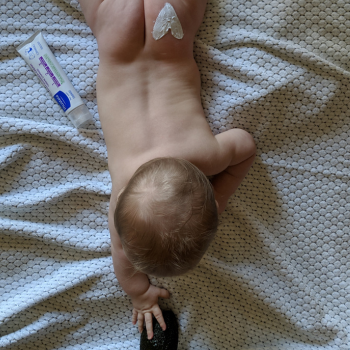Yeast Nappy Rash: Causes, Symptoms, And Treatment
Updated on May 29, 2024
Created on June 26, 2023
6 Minutes to read
AU & NZ - Find your nearest pharmacy here
Updated on May 29, 2024
Created on June 26, 2023
6 Minutes to read

Blog Summary
Nappy rash is not particularly uncommon. In fact irritation alone is what causes common nappy rash (dermatitis). But this common nappy rash differs from a yeast diaper rash.
A form of fungus called yeast (Candida) develops naturally in the human body. However, excessive growth leads to what we refer to as a "yeast infection."
The yeast infection nappy rash (also known as "yeast nappy rash") is specifically brought on by that yeast overgrowth. Simply described, it is a fungal infection.
It is not surprising that a yeast nappy rash can develop fast given that yeast prefers warm, moist surroundings. Let's examine the causes of a yeast diaper rash and the elements that make your baby's skin vulnerable.
The cause of a yeast nappy rash is simple: an overgrowth of yeast. Here are some factors that can contribute or lead to a yeast overgrowth.
As we mentioned, yeast loves warm, moist environments, and your baby’s nappy area is just that — especially in the folds of their skin.
Unfortunately, if your child has a recurring nappy rash, this indicates that their skin is already inflamed, vulnerable, and open to a yeast nappy rash. This is due to the fact that their natural skin barrier is compromised and less effective in warding off yeast.
A wonder of contemporary medicine are antibiotics.
Antibiotics can kill bacteria that may be harming you or your child, but they can also change the body's beneficial bacteria. Occasionally, a change in the good bacteria allows yeast to flourish.
As a result, infants taking antibiotics may be more susceptible to getting a yeast nappy rash. If the mum is taking antibiotics, the same is true for babies who are breastfeeding.
Thrush is in the mouth and may seem like it has nothing to do with a nappy rash, but it does!
Since thrush is also a yeast infection, the yeast can go in one end and out the other (if you know what we mean). That means it can end up in your baby’s nappy and on their bum.
So, if your baby recently or currently has thrush, it won’t be surprising if they also develop a yeast nappy rash.
If your baby’s got to go, they’ve got to go. But frequent bowel movements mean more chances for a yeast nappy rash.
This is because the excrement itself has the potential to alter the bacterial balance on the skin. Additionally, it may irritate, which, as we all know, facilitates yeast overgrowth.
Babies who recently experienced diarrhoea are more likely to get a yeast nappy rash.
Let's look at what you should be on the lookout for now that you are aware of the factors that can contribute to and cause a yeast nappy rash to develop. You can tell if your infant has this form of rash or something else entirely by recognising the symptoms.
“Clues that the rash might be due to a yeast infection include shiny, bright red or pink patches with sharp edges. This rash may also have little pink bumps or pimples. In severe cases, there may be sores or cracking skin that oozes or bleed. Unlike with irritant nappy rash, a yeast nappy rash is usually worse in the groin folds.”
In addition, a yeast nappy rash is typically well-defined and may be slightly raised on the edges. It can also have “satellite” rashes near the main rash.
And, of course, one of the clues will be that it doesn’t go away when you treat it as you would a regular nappy rash.
To help you determine which type of rash you’re dealing with, here’s a quick look at the main differences between the two.
Baby with normal nappy rash
Yeast nappy rashes are usually bright red or pink. On the other hand, normal nappy rashes often have a more flushed appearance and can be darker in color.
If the redness is worse in the folds of skin near the groin, it's likely a yeast nappy rash. An everyday, irritant-caused rash is most often found on the chubby parts of the bum.
In addition, yeast rashes may have several smaller spots throughout the nappy area. A plain rash is usually found in one larger area without the "satellite" patches.
Bumpy, cracked, or oozy skin indicates yeast is causing the rash. In addition, the red patches may have a shiny appearance. Conversely, regular rashes are usually smoother and look dry.
Yeast nappy rashes won’t respond to a regular nappy rash cream. If the rash lasts longer than three days and isn’t getting better with your home treatments, it’s likely caused by yeast.
The severity of your child's rash and how quickly you begin treating it will determine how long it takes to treat a yeast nappy rash.
It often takes between a few days and three weeks for a yeast diaper rash to completely go away once you start using an antifungal cream. Remember that the redness could fade during the healing process before the yeast overgrowth is treated.
So, once the rash has subsided, do not stop taking the prescription. Continue using the cream until you have finished the full course of treatment recommended by your healthcare practitioner. By doing this, the likelihood of the condition returning is reduced.
It's best to follow up with your baby's doctor for a new assessment if their bottom isn't getting better after a few days.
Despite having a terrible appearance, yeast nappy rashes are frequently more itchy and irritating than painful.
However, you might see your infant rubbing or trying to scratch their bums. Additionally, they could become more agitated or fussy during nappy changes. This is typical and occurs when you touch and wipe an area that Is irritated and feels uncomfortable.
Call your baby's doctor right away if they appear to be in real pain. They may offer further suggestions for how to make your child feel better.
Left untreated, the rash might ooze, become more painful, and spread. Additionally, if your infant scrapes the rash and creates more open sores, it may become infected.
Keep an eye out for any infection-related symptoms, such as a fever or red patches surrounding the rash. These signs could point to a more significant issue that needs a different course of action.
Your child's bottom may develop red patches for a variety of reasons, not just nappy rashes. Here are two additional possible reasons:
Your baby's bottom may develop red, itchy bumps as a result of impetigo or another bacterial illness. Take your child to the doctor as soon as possible if they have any elevated, fluid-filled legions or crusted-over sores.
People with psoriasis might get red, scaly skin patches everywhere on their body, even around their nappy area.
Make an appointment with your baby's doctor for a precise diagnosis if you see any of the typical symptoms of psoriasis, such as dry, patchy skin or silver-colored scales, on your baby's bottom close to the nappy area. They may need steroids or hydrocortisone cream to help clear up their skin.
First of all, it's a good idea to consult your child's healthcare practitioner if their nappy rash persists, especially if it starts to look suspicious or if they are running a fever.
The doctor can confirm if your child has a yeast nappy rash and can also suggest a course of therapy if that is the case.
Regular nappy cream is calming, but cannot get rid of yeast . Your doctor can give you advice on this and, if necessary, prescribe an antifungal cream.
In addition to the cream, it’s essential to help your baby’s skin along as it heals. Below, we’ll list several ways to care for your baby’s bum that can help with a yeast nappy rash.
But keep in mind that these are also good habits to get into to help prevent nappy rash in the first place!
Because yeast thrives in moist conditions, you should often change your baby's nappy to keep them as dry as possible. Establish the routine of checking their nappy frequently and replacing it as soon as it becomes wet or soiled.
It's crucial to gently yet completely wipe your baby's skin when changing their nappy. To clean the area, use a warm, soft washcloth.
If you would rather use baby wipes, use fragrance-free, all-natural wipes made for sensitive skin.
Mustela Certified Organic Water Wipes are designed to gently and effectively clean extremely sensitive, rashy, or reactive skin. They are incredibly soft and fragrance-free.
Additionally, they contain 99% plant-based ingredients, allowing you to gently cleanse your little one’s skin and leave it soft, moisturised, and fresh.
Instead of rubbing your baby’s bum dry and adding to the irritation, opt for air drying. When using this method, just be sure that their skin is dry before putting on a nappy again.
If you’re in a rush, try a hairdryer on the cool setting. But always test the air on your skin first, as it can be too hot for your baby’s delicate bottom.
It's usually a good idea to skip the nappy and let your baby hang around nappy-free for a while, whether it's after a nappy change to help dry their skin or in the middle of the day when you're at home.
Just be sure to place your child in an area that is simple to clean up. A soft towel works wonderfully for soaking up any spills. Additionally, it offers your child a comfortable spot to rest while airing out their bottoms.

One of the issues when you tighten your baby's nappy too tightly is that the friction can hurt their skin. Additionally, a tight nappy traps moisture within, which is precisely the opposite of what you want when dealing with yeast.
Make sure your nappy is not too tight to avoid this.
Speaking of tight nappies, if the one your baby is wearing seems to be a bit snug, try going up a size. It’s always best for your little one to have a nappy that fits properly, but it’s even more important when they have any kind of nappy rash.
Once the nappy is on, you should be able to slide two fingers under the waistband. If you can't, you should size up.
When using cloth nappies instead of disposable ones, the fabric might retain yeast for a very long period. You might not be able to completely remove it with your normal washing regimen. Unfortunately, this means that every time you change your child's nappy, you're reinfecting them.
You should soak your nappies in a cold, diluted bleach water solution for 30 minutes to eliminate yeast. Before washing them, rinse them in hot water.
The UV rays from the sun should then be used to further remove any yeast buildup as you hang your nappies outside to dry.
Because the risk of reinfection is high, many parents choose to put their baby in disposables for the duration of their yeast nappy rash. This way, they don’t worry about infecting their entire stash of cloth nappies.
This is a good rule of thumb for any nappy change, but, when dealing with a yeast nappy rash, be sure to clean your hands before and after changing your baby’s nappy. Wash your hands with soap and hot water, then scrub them for at least 20 seconds.
This helps stop yeast from spreading continuously to you and your child. If you don't practise good hygiene, you could get a yeast infection because it is contagious.

The skin of a baby is often sensitive to lotions, creams, shampoos, and other cosmetics. But you should take additional care when choosing the products you use on your infant if they have sensitive skin or a rash.
Use a soap made specifically for fragile skin to bathe your infant, such as our Soothing Cleansing Gel. This product gently cleanses your baby's skin while properly cleaning their hair and body. And it was made with rash-prone , sensitive skin in mind. It soothes skin tingling sensations and skin redness which are especially due to the irritating effect of hard water.

Once your baby’s rash is gone, you can ditch the antifungal cream. However, the rest of these tips are still good practices to stick with to help keep your baby’s skin clean and healthy.
Plus, it’s important to get in the habit of using a soothing, protecting nappy cream every day. We recommend our Vitamin Barrier Cream 1 2 3.
Getting rid of yeast might be difficult. Also, if you don't entirely get rid of it, the rash can return.
Keep these suggestions in mind to prevent yeast from growing on your baby's bottom:
Treat any yeast infections you may have. Otherwise, you risk passing it back to your baby.
If your baby is eating solid foods, yogurt is an excellent source of probiotics that can help keep yeast levels in check.
Talk to your baby’s doctor about probiotic supplementation.
Rub a bit of coconut oil on your baby's bum. The antifungal properties can help kill yeast overgrowth.
Minimise sugar intake for your baby and yourself if you're breastfeeding. Yeast feeds on sugar.
If your baby has to take antibiotics, increase their nappy-free time to get more air circulating down there.
Clean your baby well during each nappy change. Make sure you get all of the stool off their delicate skin.
Switch to gentle skincare products from Mustela to keep your baby’s skin soft and supple.
While you may not be able to completely prevent yeast nappy rashes from coming back, these steps make it less likely for it to return.
While nappy rash is common, it’s still uncomfortable for your little one! And if it’s a yeast nappy rash, you’ll need to treat it a little differently.
Care for your baby’s bum and rash as mentioned in this article in addition to discussing with your doctor and adhering to their recommendations
When you change your baby (which should be frequently), clean their skin with Soothing Cleansing Wipes, let their bottom air dry, and put their nappy on a little bit more loosely.
Finally, when your baby’s yeast rash is all gone, do what you can to prevent future nappy rash with a cream like our Vitamin Barrier Cream 123. Our Vitamin Barrier Cream soothes from the first application and offers protection that lasts until the next nappy change.
While you certainly can’t guarantee that your baby will never get a nappy rash, with careful care for your baby’s bum, you can reduce the chances and keep your little one happy and comfortable!